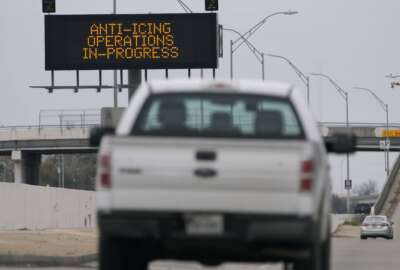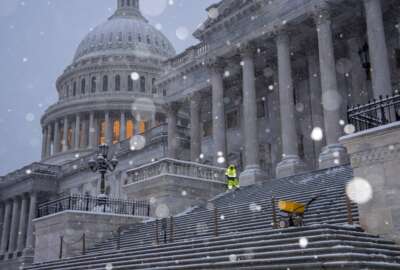USPS regulator says ‘no more important time’ for stronger oversight of agency’s sweeping changes
A USPS regulator’s recommendations are nonbinding. But the bipartisan USPS Stop and Study Act would give its decisions more authority.
Members of the Postal Service’s regulatory agency are calling on Congress to strengthen their oversight of USPS, citing declines in on-time mail delivery and its persistent financial challenges.
A bipartisan group of senators is embracing those calls for greater USPS oversight, and leading a bill that would require the agency to seek approval from its regulator before continuing network modernization plans that have led to regional mail delays.
Two commissioners at the Postal Regulatory Commission, up for another six-year term to oversee USPS, are raising concerns about USPS setting higher prices for its monopoly mail products and significant declines in on-time delivery.
USPS has seen persistent mail delays in areas where it has begun consolidating mail processing facilities into large, regional hubs. This network shakeup is a key part of Postmaster General Louis DeJoy’s 10-year Delivering for America (DFA) reform plan.
Ashley Poling, a commissioner at the PRC, told members of the Senate Homeland Security and Governmental Affairs Committee that recent USPS network modernization changes are disrupting a “critical piece of national infrastructure” that supports small businesses, and allows households to receive prescription medications and vote in elections by mail.
“It is critical that the commission hold the Postal Service accountable for meeting its statutory obligations throughout these changes, including maintaining high-quality service,” Poling said Thursday. “There is no more important time than now for a strong and engaged postal regulator.”
DeJoy has vehemently rejected calls for a stronger USPS regulator to oversee his 10-year Delivering for America reform plan.
DeJoy, in an exclusive interview last year, said USPS was putting up with “nonsense” from the commission’s inquiries into its network modernization changes, and that the probes would postpone some of the agency’s most urgent reforms as it tries to reverse long-term financial losses.
“We’re committed to the service standards. We don’t need to be babysat,” DeJoy told Federal News Network.
USPS agreed to put some of its network changes on hold until at least January 2025, after more than a quarter of the Senate and a member of the USPS Board of Governors urged the agency to put its plans on hold or slow down the pace of implementation.
Ann Fisher, another commissioner at the PRC, told lawmakers that, “in certain parts of the country, DFA-related adjustments have caused historic service performance lows.
The PRC called on USPS, in a notice earlier this month, to “pause other DFA Plan initiatives in addition to moving mail processing facilities, so that it can conduct a comprehensive study of the DFA Plan’s potential impacts on service performance.”
Poling told lawmakers the PRC has “limited authorities, but I think we’re doing as much as we can with what we have.”
Senators introduce bill to bolster USPS regulator
The commission’s recommendations to USPS are nonbinding.
But the USPS Stop and Study Act, led by Committee Chairman Gary Peters (D-Mich.) and members Susan Collins (R-Maine) and Jacky Rosen (D-Nev.), would give the regulator’s decisions more authority.
The bill would require USPS to submit a comprehensive proposal to the PRC before moving ahead with any network changes.
The PRC, citing recent mail delays in regions where USPS began its sweeping network changes, asked USPS on April 26 to start the process of obtaining an advisory opinion on its network modernization plans, or explain why such a review is unnecessary.
But it told the regulator in its response that those regional mail delays are improving, and that it would be “premature to conclude” it should seek an advisory opinion for its plans at this time.
“Our ability to analyze what’s going with Delivering for America, through an advisory opinion, would be an excellent way for us to understand what’s going on, and what the impact is on customers all over this country,” Poling said.
Members of the committee planned to markup the bill at a meeting on Wednesday, but pushed consideration of the bill to a later date.
Fisher said that under the current regulatory process, “it gives the Postal Service 100% of the power of when to determine they need to file an advisory opinion.”
“They say when something they’re going to do is going to impact the service nationwide,” she added. “I wonder if maybe the regulator should be in charge of determining when the public will be impacted and then tell the Postal Service, ‘You must file an advisory opinion request.’”
Sen. Roger Marshall (R-Kan.) said USPS “has to accept responsibility for the decreased volume, because of customer satisfaction issues.”
“Volumes are going down, and there’s worse customer satisfaction, which leads to less volumes, which leads to worse customer satisfaction,” Marshall said. “This is a circular problem.”
A recent USPS inspector general report found more than 100,000 pieces of delayed mail over three days at a processing facility in Kansas City, Missouri. The plant manager also told auditors that the site sees about 10% unscheduled absences from employees, on average, on any given day.
Marshall told Peters he’d support efforts to increase USPS oversight of its network modernization plans.
“Mr. Chairman, I would just ask for an opportunity to sit down with your staff and our staff and help me to understand a little bit better how we can make the Postal Service more accountable to somebody,” Marshall told Peters. “It sounds like, right now, that they’re not accountable to anybody.”
“We’d be happy to have that conversation,” Peters said.
USPS prices ‘not enough’ to fix financial challenges
USPS relaxed its service standards in 2021, which impacted about 40% of first-class mail.
But the agency, starting last year, has seen a decline in on-time delivery. But even by making its targets easier to achieve, USPS is falling short of on-time delivery metrics.
“This organization visits every American address six days per week and has existed since the time of the founding fathers. And yet in the last several years, the confidence of the American people in their public Postal Service has begun to slip,” Poling said. “I believe transparency and accountability in this area is now more essential than ever,” she added.
Lawmakers in regions hardest hit by regional delays— such as Atlanta and Richmond, Virginia — say on-time performance is improving. But Sen. Tom Carper (D-Del.) said those metrics still aren’t where they need to be.
“This quality of service is not getting better. In many cases, it’s getting worse. And we find that we’re losing money — maybe more than ever. That’s not a good combination,” Carper said. “It’s not all on the Postal Service. It’s not all on the people who work there. It’s not all on the commission. It’s not on us, on this committee. But we’ve got to find a way to a better place for the people we serve, and frankly, for the people who work for the Postal Service.”
Fisher told lawmakers that the commission could allow USPS to set even higher prices, “but that alone is not enough to return the service to a state of financial viability.”
“There are legitimate questions as to the effects of the much-accelerated pace at which the Postal Service is increasing rates, given how much mail volume has and is being lost,” Fisher said.
Poling agreed that higher mail prices alone won’t fix the Postal Service’s long-term financial problems. The agency ended fiscal 2024 with a $6.5 billion net loss. It expects to see a similar loss by the end of this year, far from its original plan to “break even.”
USPS mail volume continues to decrease each year, and a dropped 9% in 2023.
Since 2007, USPS has lost 48% of its total mail volume. The agency saw a major decline in mail volume after the 2008 Great Recession, but Poling said the COVID-19 pandemic also accelerated mail declines.
“It never rebounded fully from COVID,” she said.
Despite its challenges, USPS still delivers billions of pieces of mail and packages every year, and is the backbone of a trillion-dollar e-commerce industry.
USPS is focused on growing its package business to capture a greater share of the business from private shippers like UPS, FedEx and Amazon. The agency saw some package growth during last year’s peak holiday season, but PRC commissioners said the agency’s package business, so far, isn’t enough to cover its total operating costs.
“Ultimately, though, the question of whether financial sustainability can be achieved while maintaining high levels of service will depend on sufficient demand for postal products,” Fisher said.
Congress passed the Postal Service Reform Act in 2022, which eliminated a 2006 mandate to pre-fund retiree health benefits well into the future, and forgave $57 billion in scheduled payments to that fund that USPS failed to meet.
Despite the legislation, Fisher said USPS still has “a tremendous amount of unfunded liabilities,” including billions of dollars in loans from the Treasury Department, high labor costs (including workers’ compensation claims) and retiree pensions.
“I don’t know that we could, alone, improve the financial viability of the Postal Service,” Fisher said. “We can assist them, to a small degree, through rate authority. But much of the rest depends upon the public’s desire for their product, and as I just laid out, that’s waning. I wonder if it’s time to potentially revisit the entire business model of the Postal Service.”
Other countries, she added, are looking at the same problem. Some options include cutting delivery days or lowering service standards.
“I’m not saying that’s the answer here,” Fisher said. “Lowered service standards certainly don’t seem to be what the American public wants. But these are things that it may be time to revisit.”
DeJoy told Federal News Network in April 2022 that he doesn’t support USPS cutting delivery days.
“You would never touch that,” DeJoy said.
President Joe Biden nominated Fisher and Poling to serve another six-year term as commissioners at the PRC. Both have already served one term at the PRC, and previously worked as Senate staffers addressing USPS issues.
USPS regulator probes higher prices, delivery metrics
PRC has ongoing reviews into how USPS measures on-time delivery and tracks performance metrics, as well as USPS models on price elasticity — or how much demand for its products changes with higher prices.
“There are legitimate questions as to the effects of the much-accelerated pace at which the Postal Service is increasing rates, given how much mail volume has and is being lost,” Fisher said.
Fisher said the PRC is also reviewing whether the way USPS measures on-time performance is “accurate, reliable and representative of the system as a whole.”
“The DFA has made significant changes to the way the Postal Service transports the mail, moving it around, the times of delivery. And we believe that the service measurement system may not be as accurate as it had been previously,” Fisher said.
The commission has also initiated a review of USPS’ ability to set higher prices two years earlier than required.
“I really do think the goal of the system is really to find a way to find this balance between keeping the Postal Service self-sustaining and also finding incentives to reduce cost,” Poling said.
USPS raised the price of a first-class Forever stamp to 73 cents on July 14, up from 68 cents. It’s the sixth price increase since 2020, when the Postal Regulatory Commission gave USPS freedom to set prices higher than the rate of inflation.
The regulator approved the latest price increase, but told USPS to make judicious use of its newfound flexibility to set prices higher than the rate of inflation.
“The commission strongly encourages the [USPS Board of] Governors to consider exercising their business judgment, consistent with statutory and regulatory requirements, not to increase rates by the full amount permitted by law,” the PRC wrote.
PRC ‘very concerned’ about election mail
Given recent mail delays, members of the committee raised concerns about on-time delivery of mail-in ballots ahead of November’s election.
The Associated Press reports state election directors from across the country are raising concerns to USPS officials that the agency won’t be ready to deliver ballots on time.
According to the AP, Steven Carter, manager of election and government programs for USPS, told state election officials that the USPS inspector general’s office will release a report next with “encouraging” performance numbers.
USPS delivered mail-in ballots in the 2022 midterm election more quickly than it did in 2020, when the pandemic led to a historic surge of voting by mail.
USPS, in its 2022 post-election analysis report, found it delivered at least 105.4 million ballots during the midterm election season.
USPS said it delivered 98.96% of general election ballots within three days, and that on average, it delivered ballots in less than two days.
In 2020, the agency delivered 135 million mail-in ballots, and delivered 97.9% of ballots within three days.
Fisher said USPS will continue to rely on extraordinary measures ahead of the election — such as running “all clear” sweeps for ballots at post offices and mail processing plants at the end of every day, running more trucks and offering more overtime.
“But I am very concerned about the impact of the slower delivery times with Delivering for America and how that may impede election mail delivery,” she said.
Sen. Maggie Hassan (D-N.H.) said USPS employees are well-trained on how to prioritize ballots, but feared recent changes in USPS operations would hamper this workflow.
“When I talk to Postal Service employees who are on the ground in the processing rooms, what they know at election time is when they see ballots, they prioritize them,” Hassan said. “By putting in rigid requirements all the time, what they’re doing is saying to a group of postal employees who see a stack of ballots coming in, and know that there’s just one more group that needs to come in before the truck should go out — what the Postal Service is telling them to do is just get the truck out, no matter what they know is coming,” Hassan said.
Copyright © 2025 Federal News Network. All rights reserved. This website is not intended for users located within the European Economic Area.
Jory Heckman is a reporter at Federal News Network covering U.S. Postal Service, IRS, big data and technology issues.
Follow @jheckmanWFED






